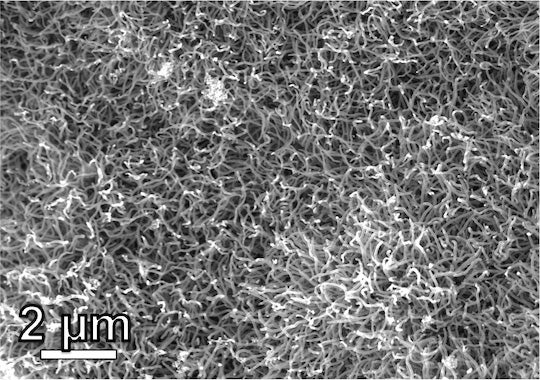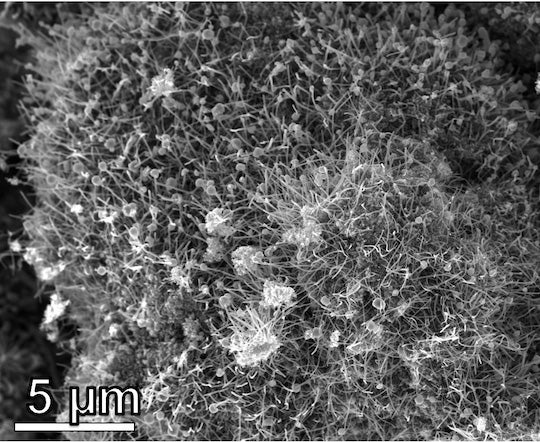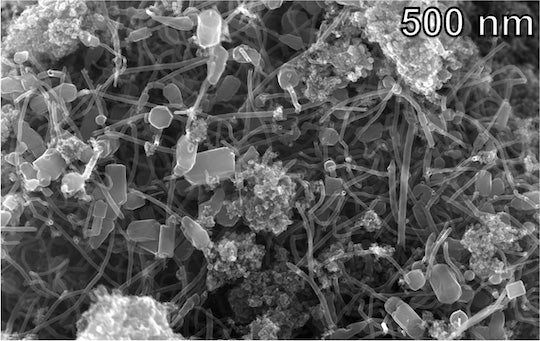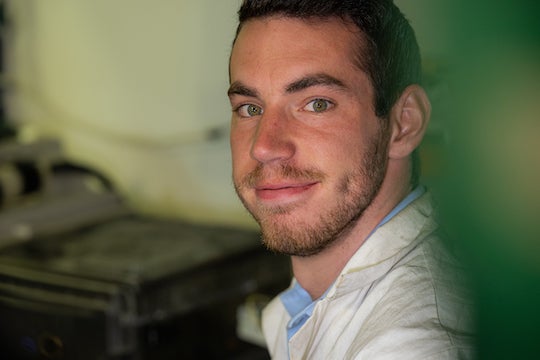Putting that soda bottle or takeout container into the recycling bin is far from a guarantee it will be turned into something new. Scientists at Rice University are trying to address this problem by making the process profitable.

The amount of plastic waste produced globally has doubled over the past two decades — and plastic production is expected to triple by 2050 — with most of it ending up in landfills, incinerated or otherwise mismanaged, according to the Organization for Economic Cooperation and Development. Some estimates suggest only 5% is actually being recycled.
“Waste plastic is rarely recycled because it costs a lot of money to do all the washing, sorting and melting down of the plastics to turn it into a material that can be used by a factory,” said Kevin Wyss, a Rice graduate student and lead author on a study published in Advanced Materials that describes how he and colleagues in the lab of chemist James Tour used their flash Joule heating technique to turn plastic into valuable carbon nanotubes and hybrid nanomaterials.
“We were able to make a hybrid carbon nanomaterial that outperformed both graphene and commercially available carbon nanotubes,” Wyss said.

Graphene, carbon nanotubes and other carbon-based nanomaterials are generally strong and chemically robust, have low density and lots of surface area, and possess conductivity and broadband electromagnetic absorption abilities. This makes them useful in a variety of industrial, medical and electronics applications such as composites, coatings, sensors, electrochemical energy storage and more.
“What was really interesting about our results this time is that we were able to make these carbon nanotubes with bits of graphene attached on the ends,” Wyss said. “You can think of the structure of this new hybrid nanomaterial as similar to bean sprouts or lollipops. These are normally really hard to make, and the fact that we were able to make them out of waste plastic is really special.”
The structure of the new hybrid carbon nanomaterial is responsible for its enhanced performance.

“Let’s say I was trying to pull a string of yarn out of a sweater,” Wyss said. “If the string is straight and smooth, it can come out quite easily sometimes and ruin the weave. It’s the same with the carbon nanotubes; having these masses of graphene attached at the ends helps make them much harder to remove, thereby strengthening the composite.
“You can also think of it this way: If you get a splinter, it’s easy to take out. But if you get pricked with something that has a curve on the end, like a fishing hook, it’s a lot harder to take out,” he added.
The plastic, which does not need to be sorted or washed as in traditional recycling, is “flashed” at temperatures over 3,100 kelvins (about 5,120 degrees Fahrenheit). “All we do is grind the material into small, confetti-sized pieces, add a bit of iron and mix in a small amount of a different carbon — say, charcoal — for conductivity,” Wyss said.
“Recycling plastic costs more than just producing new plastic,” he added. “There's very little economic incentive to recycle plastic. That's why we turned to upcycling, or turning low-value waste materials into something with a higher monetary or use value. If we can turn waste plastic into something more valuable, then people can make money off of being responsible in how they deal with discarded plastics.”

A life cycle analysis of the production process revealed that flash Joule heating was considerably more energy-efficient and environmentally friendly than existing nanotube production processes.
“Compared to commercial methods for carbon nanotube production that are being used right now, ours uses about 90% less energy and generates 90%-94% less carbon dioxide,” Wyss said.
Tour, a co-author on the study, is the T. T. and W. F. Chao Professor of Chemistry and a professor of materials science and nanoengineering in Rice’s George R. Brown School of Engineering.
The National Science Foundation Graduate Research Fellowship, the Air Force Office of Scientific Research (FA9550-19-1-0296) and the U.S. Army Engineer Research and Development Center (W912HZ-21-2-0050) supported the research.
-30-
- Peer-reviewed paper:
-
Upcycling of Waste Plastic into Hybrid Carbon Nanomaterials | Advanced Materials | DOI: 10.1002/adma.202209621
https://doi.org/10.1002/adma.202209621Authors: Kevin Wyss, John Li, Paul Advincula, Ksenia Bets, Weiyin Chen, Lucas Eddy, Karla Silva, Jacob Beckham, Jinhang Chen, Wei Meng, Bing Deng, Satish Nagarajaiah, Boris Yakobson and James Tour
- Image downloads:
-
https://news-network.rice.edu/news/files/2023/02/220411_Wyss_Fitlow_LG.jpg
CAPTION: Kevin Wyss is a Rice graduate student and lead author on the study. (Photo by Jeff Fitlow/Rice University).https://news-network.rice.edu/news/files/2023/02/2302_Tour_img1_LG.jpg
CAPTION: Flash Joule heating can be used to make carbon nanotubes and carbon nanofibers from mixed waste plastics, a method that is 90% more efficient than existing production processes. The nanotube diameter can be controlled by changing the power or catalyst used. (Image courtesy of Tour lab/Rice University)
https://news-network.rice.edu/news/files/2023/02/2302_Tour_img3_wscale_LG.jpg
CAPTION: By controlling the reaction parameters, a hybrid carbon nanomaterial consisting of nanotubes with graphene-sheet bits attached to their ends was obtained from mixed waste plastics. When used in composites, these hybrids performed better than either graphene or carbon nanotubes alone. (Image courtesy of Tour lab/Rice University)
https://news-network.rice.edu/news/files/2023/02/2302_Tour_img4_LG.jpg
CAPTION: By controlling the reaction parameters, a hybrid carbon nanomaterial consisting of nanotubes with graphene sheet bits attached to their ends was obtained from mixed waste plastics. When used in composites, these hybrid morphologies performed better than either graphene or carbon nanotubes alone. (Image courtesy of Tour lab/Rice University)
- Related stories:
-
Cars could get a ‘flashy’ upgrade:
https://news.rice.edu/news/2022/cars-could-get-flashy-upgradeMachine learning fine-tunes flash graphene:
https://news.rice.edu/news/2022/machine-learning-fine-tunes-flash-grapheneFlashing plastic ash completes recycling:
https://news.rice.edu/news/2021/flashing-plastic-ash-completes-recyclingGraphene gets enhanced by flashing:
https://news.rice.edu/news/2022/graphene-gets-enhanced-flashingRice lab turns trash into valuable graphene in a flash:
https://news.rice.edu/news/2020/rice-lab-turns-trash-valuable-graphene-flash - Links:
-
Tour Group: https://www.jmtour.com/
Department of Chemistry: https://chemistry.rice.edu/
George R. Brown School of Engineering: https://engineering.rice.edu
Wiess School of Natural Sciences: https://naturalsciences.rice.edu/
- About Rice:
-
Located on a 300-acre forested campus in Houston, Rice University is consistently ranked among the nation’s top 20 universities by U.S. News & World Report. Rice has highly respected schools of Architecture, Business, Continuing Studies, Engineering, Humanities, Music, Natural Sciences and Social Sciences and is home to the Baker Institute for Public Policy. With 4,552 undergraduates and 3,998 graduate students, Rice’s undergraduate student-to-faculty ratio is just under 6-to-1. Its residential college system builds close-knit communities and lifelong friendships, just one reason why Rice is ranked No. 1 for lots of race/class interaction and No. 1 for quality of life by the Princeton Review. Rice is also rated as a best value among private universities by Kiplinger’s Personal Finance.

